Archive for the ‘#nymphing’ Tag
Feel Your Way…….
Hidy Ho Good Neighbors,
So, have you tried Euro style nymphing yet? I know, sounds funny coming from a guy that wrote a book about the systematic approach to nymphing, but I have done a fair amount of this technique over the last couple of years. Even have my clients working a modified euro system on pretty much every guide trip.
Now, I’m no expert on euro style, but I appear to be qualified enough to talk about it because my clients catch plenty of fish, even on the first time out, using my quirky method. I tagged my method “eurorado nymphing” because it includes Colorado nymphing methods coupled with euro-style principles. I’ve included a section in my latest book, Hidden in Plain View, that goes into greater depth on what I do.

A good stocking stuffer
Suspended nymphing under an indicator still has a place in my arsenal as it can create longer more consistent drifts, gives you the ability to work water that is more than a couple rod lengths away, and gives you the ability to see fish eats thru the indicator. However, the ability to work the upper half of a drift effectively while dialing in drift speeds is a bit tougher under an indicator. Think back to the last time you nymph fished, how many fish did you catch upstream of the halfway point of your drift? Exactly, it’s hard to recall because it just doesn’t happen as often as the fish you catch from the middle to end of the nymph drift. That’s because that is when most anglers have the depth and speed finally perfect.
Eurorado style, on the other hand, allows you to work the upper part of the drift well. It allows you to feel working over obstructions, shelves and bars. And, you catch the majority of the fish above the middle point of your drift, because you get the bugs down quickly, and dial in depth and speed quickly after your bugs hit the water. Each method has its merits, but like I always say, the more versatile an angler you are, the more you’ll enjoy the sport.
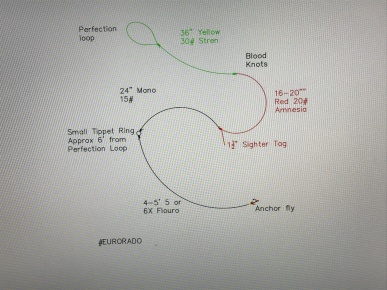
Customize as needed
Some days Eurorado nymphing is like a vacuum, picking up fish in a river where suspended nymphing wouldn’t be able to and it’s relatively easy to rig and learn. Again, I’m no expert, but there are many videos available that can get you started. As for gear, I run a 10’6” 3 weight Master Nymph Bellator fly rod with a matching Lamson Liquid reel. This rig is balanced and light weight with incredible accuracy and fish fighting capabilities. I also employ a sighter-leader of my design and use bugs of my design.
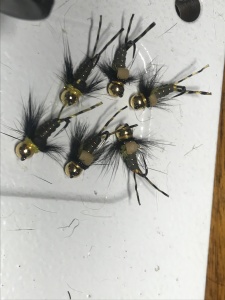
A gaggle of Booby Traps
The sighter-leader and flies used is where I put the “rado” in this rig, because it smacks of Colorado nymphing. Most Euro-style leaders are around twenty feet (and longer) lengths, whereas my leader is around eleven feet long. It is comprised of several different sections of monofilament, fluorocarbon, and amnesia lines, with a sighter tag and tippet ring thrown in for a cause (see pic). As for my bugs, I run a weighted Booby Trap, as my anchor, and run in-line off of that. So, off the bend of the Booby Trap, I run tippet to a DP643 which is an unweighted soft hackle, and off of that bend I run a Butt Crack Baetis (unweighted) in the appropriate size and color. I’m sure you can see the indicator nymphing influence here.
This rig has served me and my clients well over the last couple of years on the Eagle River, and it can easily be customized to your favorite water with a little thought and tinkering. I continue to learn a bit more each time my boots get wet, but I am sold on this technique. I really enjoy the simplicity, ability to feel your way along a river bottom, and the consistency to get depths and speeds dialed in quickly on every drift.
That’s my story and I’m sticking to it…….Fear No Water!
Happy Holidays!
Of Redds and Run-off
Every year I hear the same old crap about folks ripping spawning fish off Redds. Drives me crazy, infuriates me really. How can you interrupt something as sacred as spawning fish? That’s our guarantee for future fishing, and there ain’t nothing wrong with wild fish, or the fish helping out in the quest for more fish. Our respective game and fish departments can’t do it all.
Maybe some folks just don’t know what to look for, so here goes: look for water up to about thirty inches deep with areas that looked like they’ve been swept with a broom. Usually, this is a flatter section of the river, with slower moving water. Also, look for one or more fish sitting atop this swept out area. I’ve seen redds the size of a coffee table, up to the size of an auditorium. Both are equally easy to spot if you’re paying attention.
You may be thinking, “So where do I fish then?” The answer is simple, “Not on the redd, but above or below it.” Target the species not spawning on the shelves and pools below spawning fish. Hmmmmm, wonder what patterns to throw…You can certainly toss egg patterns in your nymph rigs and follow that up with the fly of the day, or the dominant hatching insect. No mystery, really, just do your best to be observant, step around the redds, and fish anywhere but on them.
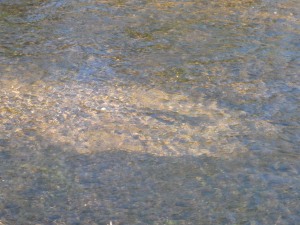
Pretty dang obvious Redd. Just observe.
Run-off is bearing down on us as the water rises and goes off color. My day usually starts out nymphing two and three bug rigs under an indicator, using darker and sparser bugs. I like weighted flies (odd for me, but conditions call for it), with dark and sparse materials, to get the bugs down quickly and allow the fish to readily see them. The darker colors are easier for fish to see in off-color water. I tie my favorite flies in black, purple, red, and even throw in some true fluorescent orange and pink collars to provide for “hot-spots” and visibility.
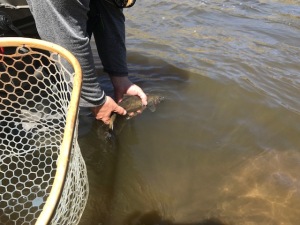
Little dirt in the drink.
Lately, my days have been ending throwing the mini-rig (it’s in the book), with a black Chubby Chernobyl followed by a black soft hackle (DP643), and a size 18 purple Butt Crack Baetis. Killer. The fish are moving to the edges and up into the riffles (not redds) to consume baetis swimmers and emergers, and the occasional skwala stones and migdes. You’ve all heard me preach about carrying two rigged rods, well this time of year is perfect for it. So, mornings I work bottom up, afternoons, top down.
Don’t hesitate to rip streamers as the water’s rising, that can be as productive as it is fun. I like to run tandem rigs with a white or lightly colored streamer up front, followed by a Slumpbuster or similar 20# below on 2 or 3 X tippet. I like to tie a loop knot to the trailing streamer to allow for a bit more movement. Typically, I’ll run a five to six foot tapered leader down to 2 or 3X to my first streamer, tie off the bend with the same to my terminal meat. If you’re not moving fish, you’re probably above their level, so employ more weight, casting angles, or mending techniques to get those streamers deeper. Vary your retrieves, strip set, and hang on.
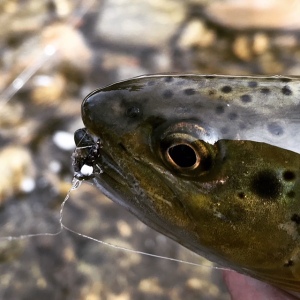
Black soft-hackles during run-off
As we get into full-blown chaos with run-off, focus on the banks, edges, eddy’s, and sleeper seams out from the banks. Just be damn careful stepping into crazy water. Dress appropriately, use a wading staff, take a friend, and show discretion and common sense. It’s not worth dying for.
A few nymphs to consider for run-off:
Black Pat’s Rubberlegs
Black Leeches
Cranefly Larva
Black Soft-Hackles (#16-18)
Purple Butt Crack Baetis (#18)
Purple, Pink or Red San Juan Worm
Various Egg patterns
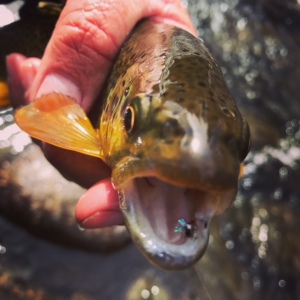
Purple Butt Crack Baetis
Fear No Water…except during run-off
Baby it’s cold outside. So cold that the Blue Wings are bygone, the PMD’s stopped popping, the Stone flies are stoned, and the Tricos are trippin’. What to do? Well, now’s the time of year to hone your skills on your favorite tailwater. Winter affords you the opportunity to work on skills that you’ve been meaning to get to. I enjoy fly fishing through the winter, here are a few reasons why.
- Less crowds.
- Gin clear, skinny, challenging water.
- Research and Development.
- Simply beautiful.
Although the calendar doesn’t agree, it’s winter for trout and the insects that feed them. Water is cold and the bugs are less prolific, except for one little tiny giant of a bug, the midge. Tiny in stature but a giant in sheer numbers, midges feed trout year round, but are mostly the only game in town during winter months. Trout depend on them as a food source.
Let’s talk water characteristics before we go too deeply into midges. Where I guide, the air temperatures don’t mean much at all compared to water temperatures. When the water hits about 39 degrees, the trout start to feed in my favorite tailwater, the South Platte. Not a bad idea to carry a thermometer, hit water that has sun exposure first, and get used to layering up to stay warm.
Obviously, the river is going to be a lot less crowded. This is important for several reasons, but two come to mind directly. One, it’s a great experience to slow down your fly fishing because you don’t have to bust tail getting from one spot to the next, and you can slow your cadence to match the river, because you’re not constantly looking over your shoulder. Two, there’s a lot less pressure on the fish as well. They will settle into winter holds, and when conditions are ripe, they eat readily. You have a chance to hook a fish of a lifetime.
Winter holds are just that. Places where fish have to migrate to in each section and run to get a crack at the best food, oxygen and shelter. They ALL migrate there. Big, medium, small will inhabit the same winter hold. Look for areas that contain the big three needs, and confirm that by locating fish. I always tell folks to fish 4 seasons, especially on the same river. You will see characteristics that don’t present during the other seasons. You’ll notice new scoured out areas that consistent low flows create, obstructions that aren’t always visible, and you’ll locate prime lies because of gin clear water.
With these river conditions come new challenges in presenting bugs. You may have to drop in tippet size (6X), decrease indicator size or go with yarn, and you get to hone skills throwing small dry flies, or ripping big streamers after bigger fish. Gin clear water helps you locate fish, but presenting without spooking is easier said than done. I always set a winter fly fishing goal I want to work on. Last year was nymphing without an indicator. This winter I’m not sure, but I’m leaning toward working on photography skills. It’s a great challenge.
Back to the tiny giant. The midge, or chironomid, is nothing more than a non-biting mosquito. Where legal, I’ll nymph a 3 bug rig under an indicator. This rig consists of an attractor nymph like a scud, egg pattern, or San Juan worm, followed by a midge larva, then a midge pupa pattern spaced as shown in my crude little drawing.

Speaking of crude little drawings, I’ve added a couple of my favorite midge patterns and the recipes to tie them. Remember, the pupa is your last fly in the rig because it is generally highest in the column.

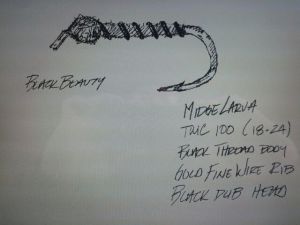
It’s my favorite time of the year to fly fish. Fly fishing in a mild snow fall is an unbelievable experience. Barometric pressures seem to play a bigger role in effecting winter time fishing than other times of the year. I try to fish as a low pressure system approaches, or pressures have been stable for a couple days. You can catch fish any time, but my notes reinforce my approach to fishing and barometric pressures.
Well folks, Happy Thanksgiving, Happy Winter time fly fishing, and don’t forget to pick up a copy of The Fly Fishers Playbook for your favorite angler for Christmas!

Fear No Water,
Duane
Hidy Ho good neighbors,
Little tardy with the post this week. This time of year gets tough, in that, I am combining fly fishing, upland game, and speaking engagements into a 24 hour day. Not complaining, but I will be happy when guiding pheasant hunts is over the end of this month. By the way, I guide on a private ranch, so seasons are longer than public stuff.
Had a couple great fly fishing trips last week. The fishing has been good. I really focused last week on working the angles with my clients. By that I mean we worked runs effectively and efficiently utilizing typical depth, speed, profile, and color principles (D,S,P,C), but added in angles.
All else being equal, a slight variation in a casting angle can change the presentation just enough to illicit a fish-eat. It’s the next step in becoming a good nymph fly fisher. The ability to pick or squeeze out the last bit of fish holding water can make all the difference in the world in the number of hook-ups.
Let’s say you’re fishing a run, have the D,S,P,C dialed in and feel as if you’ve picked the run apart perfectly. Before you walk away, try to change angles. I suggest subtle movements, left, right, forward, back, or a combination of those to fully cover the water. You may have prefectly drifted a seam, but missed a feeding fish by mere inches. Maybe the fish is swinging 6″ right and left, and you are drifting just outside that zone. Since, you can’t be exactly sure where your bugs are throughout the entire drift, a simple angle change can make the difference. Folks that fish with me will attest to this, it is amazing how many fish we pick up after a subtle angle change. “If you change nothing, nothing changes”.
Also, I see clients continue to pound the same part of a seam, and every time they are hooking up on the same obstruction. A subtle change will get you past that obstruction, and because of how fish hold around obstructions, it’s not unusual to catch a fish after an angle change by that very obstruction that was “in the way”.
In the picture I am posting about how to attack a bend, really look it over as to how to cover the bend completely. What is left out is how to finish each stage by subtle angle changes, before moving to the next stage. Just too hard to show graphically. Look at it this way, after you’ve finished a stage, use your intuition to dictate to you what angle change is necessary to completely cover the run. Sounds silly, but it works.
The longer you nymph fish with the same set-up, the more “intuitive” you become. You begin to “see” your bugs underwater, and realize the angle change to finish the run. It’s called angling for a reason.
I explain this concept further in The Playbook, and will sometime post a video. You may not catch fish in each run, but I promise you’ll walk away from it knowing you fished it well. For now, Fear No Water! Thanks for dialing in.
Duane

I had the opportunity to visit quite a bit with Eric Stoup from Pennsylvania. Eric is a guide, author and speaker of high order. Eric and I spent a lot of time discussing nymphing techniques. He nymph fly fishes without an indicator. During our discussions I decided I would give his methods a try.
I always have felt that the more versatile a fly fisher you can be the better. So, armed with a leader that Eric designs and builds himself, a picture in my mind of how to rig bugs and weight, and a 9′ 5weight TFO, I hit the river.
Right away I realized how helpful an indicator is. So lost without it. I caught fish, some by accident, others on purpose, but an indicator for tailwater fish is a great tool. Tailwater fish have a tendency to take bugs gently. It was hard to detect a strike. I’m not saying Eric’s methods don’t work, on the contrary they do, but I’d have to log in many more hours to feel proficient. Funny, that’s the way I learned to nymph.
I think that the simple fact that I worked on that method for a half day, I became a better fly fisher. I had to really tighten up the drift, had to “feel” the fish, and had to be more attentive to everything. I certainly employ it again sometime, and I can envision it being a go-to method of nymphing on a few waters I fish like Clear Creek and the Middle Fork. It’s fun.
Eric’s method works. To learn how to employ it you can buy a copy of his first book, Common Sense Fly Fishing: 7 Simple Lessons to Catch More Trout.

Pictured is a Cuttbow I picked up nymphing sans indicator. I “felt” this fish eat.
Stay tuned- next week I will post a video on long line mending.
Fear No Water!
Duane
Hidy ho, good neighbors. I had a great conversation with two fly fishers in the fly shop yesterday. Both had read my book, but wanted further clarification on the dimensions of the nymph drift.
I used to only think about the “horizonatal mend” during the drift. The mend that allows you to place line above, below, or a combination of both, of your fly line to get a drag free drift. By the way, I don’t like to use the term “dead drift”, I want those bugs to look “alive”, real. So, to achieve a “live” drift, the angler must either take line off the water, and/or mend the line to allow for minmal drag on the flies. Drag, simply put, happens when your flies are forced to go too fast or too slow and look unnatural to the fish.
Mastering the horizontal mend comes with time and attention to detail. As you become proficient you become to “see” the bugs in your mind’s eye. Don’t call me crazy, it’s true. You begin to have experience and expertise that allows you the chance to know exactly where your bugs are in the drift. However, and this is a big however, if you don’t realize the need for a vertical dimension within the drift, you will never really master the nymph drift.
If you took a cross section of the river and studied the dynamics of water speeds you would notice that the surface speed of the water is travelling roughly twice as fast as the water at your feet (grade). If you look at the diagram you will see what the forces are doing to your leader sub-surface. Yup, it’s creating drag. So, you could have your weight dialed in perfectly, but STILL be getting ugly drag on your bugs. The longer the drift, the more vertical drag you add to the drift. That’s why I employ the “pause mend”.
The pause mend is just that. Somewhere in mid drift, all you need to do is pause the indicator for just an instant. You will immediately see a difference in the drift. What happens is the paused indicator allows the leader to catch up to the drift, and you simply “release” it to finish the drift. Once you have it you will not only start picking off more fish, but you will become better at all facets of nymphing, especially sight nymphing. It’ in the Fly Fishers Playbook, it should be in yours!

Fear No Water!
Duane














